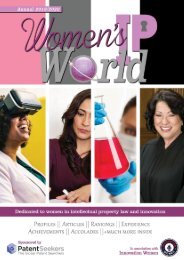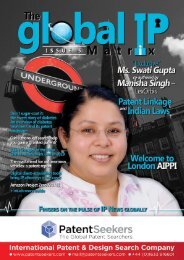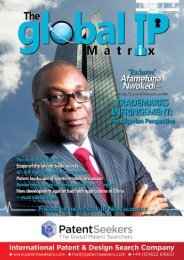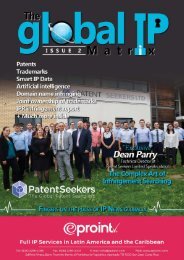Global IP Matrix - Issue 6
HAPPY NEW YEAR 2020 to all our readers. It has been a fantastic year for The Global IP Matrix, and 2020 is shaping up to become an even bigger and productive year for us. We have kept to our promise of giving our readers diverse news from the IP world straight from the frontline and hope you agree! We want to thank all our amazing contributors and give them credit for all the content they have submitted to us over the year. Without their expert knowledge, we would not be where we are today. We endeavor to provide our readers with engaging and up to date topics, written by specialists in the industry at all levels with an unbiased approach. Our ethos is ‘each one teach one', shared knowledge is key. We look forward to continuing to provide the right content to keep you wanting to read more in the coming year. Please enjoy this issue and look out for us again in a few months. From all of us at The Global IP Matrix & Northon’s Media, PR & Marketing
HAPPY NEW YEAR 2020 to all our readers.
It has been a fantastic year for The Global IP Matrix, and 2020 is shaping up to become an even bigger and productive year for us. We have kept to our promise of giving our readers diverse news from the IP world straight from the frontline and hope you agree!
We want to thank all our amazing contributors and give them credit for all the content they have submitted to us over the year. Without their expert knowledge, we would not be where we are today.
We endeavor to provide our readers with engaging and up to date topics, written by specialists in the industry at all levels with an unbiased approach. Our ethos is ‘each one teach one', shared knowledge is key.
We look forward to continuing to provide the right content to keep you wanting to read more in the coming year. Please enjoy this issue and look out for us again in a few months.
From all of us at The Global IP Matrix & Northon’s Media, PR & Marketing
Create successful ePaper yourself
Turn your PDF publications into a flip-book with our unique Google optimized e-Paper software.
BRAND
PROTECTION
Counterfeits are costing the
UK Economy Billions
Counterfeit trade in the UK economy continues rising to epidemic levels.
The UK is one of the most affected
by global counterfeiting and piracy.
According to a recent OECD study
(2019), the UK ranks eighth on the
list of economies whose Intellectual
Property Rights (IPR) suffers from
counterfeiting.
When combined, the trade in fake UK IPR
products and UK imports of counterfeit goods
resulted in just under 87000 loss of Jobs for
UK industries and a staggering loss to the UK
Government of £4bn in foregone Tax Revenues.
Additionally, the total Loss of Consumers’
Welfare for UK consumers of £4.8bn.
Despite this astronomical financial damage
to the UK economy, just under half of the
counterfeit and pirated goods imported to the
UK were bought by UK consumers who were
fully aware they were buying fakes.
Trade in counterfeit goods is a
longstanding, worldwide socioeconomic
risk that is growing in scope
and magnitude. It challenges effective
governance, efficient business, and
consumer well-being, and has become
a key source of income for organised
criminal groups. © OECD, 2019
Trade in Counterfeit Products
and the UK Economy: Fake
Goods, Real Losses, OECD
In 2017, an in-depth assessment of the level
of trade in counterfeit and pirated goods in
the United Kingdom (UK), was conducted,
based on 2013 data. The results were published
by the OECD in a report called the Trade in
Counterfeit Products and the UK Economy:
Fake Goods, Real Losses.
In a new study, an update of the results of
the 2017 report have been revealed, based
on a 2016 dataset, providing a quantitative
assessment of the economic impacts through
a methodology that was developed as part of
the 2017 study.
The purpose of this recent study was to better
understand the effect of counterfeit trade on
the UK economy. The study was two-pronged;
Lisa Lovell, CEO at Brand Enforcement UK BEUK, reports…
www.brandenforcement.co.uk
firstly, it introduced a methodology in order to measure the scale of counterfeit trade on the UK
economy and provide an understanding of how this affects not only the revenue of UK IPR holders
but also the revenue of the UK government. Second of all, the study applied this methodology to
establish findings which confirmed that the problem with counterfeiting and piracy is continuing
to escalate in the UK economy as well as others.
This study, conducted by the OECD’s Task Force on Countering Illicit Trade, and the
report prepared by the OECD Public Governance Directorate. The quantitative research
in this study relied on a rich global database on customs seizures, provided by the
World Customs Organisation (WCO) and supplemented with regional data submitted
by the European Commission’s Directorate-General for Taxation and Customs Union,
the US Customs and Border Protection Agency and the US Immigration and Customs
Enforcement. © OECD, 2019
The new study provides an updated and further insight as to the effects of the global trade in
counterfeit goods on the UK economy from two perspectives; The effect of counterfeit and
pirated products produced outside but imported into the UK and the effect of counterfeit and
pirated products on products produced within the UK;
The effect of counterfeit and pirated products imported into the UK;
1 Loss of Sales for UK industries (retail and wholesale sectors) £9.2bn
2 Loss of Tax Revenues for UK government; (retail and wholesale sectors) £3.1bn
3 Loss of Jobs for UK industries (retail and wholesale sectors) 60,000
4 Loss of Consumers’ Welfare for UK consumers £4.8bn
The effect of counterfeit and pirated products on UK IPR’s;
5 Loss of Sales for UK right holders £11bn
6 Loss of Tax Revenues for the UK government (manufacturing sector) £897m
7 Loss of Jobs for UK industries (manufacturing sector) 27,000
1. Loss of Sales (UK Retail and Wholesale sectors)
£4.2bn Loss of Sales (2013), or 1.4% total sales of UK wholesale and retail sectors in that year
£9.2bn Loss of Sales (2016), or 2.7% total sales of UK wholesale and retail sectors in that year
The loss of Sales in the UK Retail and Wholesale sectors is on the rise; it has increased by
approximately £5bn since 2013.
2. Loss of Government Revenue (UK Retail and Wholesale sectors)
Lower sales in the retail and wholesale sector due to counterfeit and pirated imports in the UK
mean lower tax revenues for the UK Government;
£582.66m (CIT) Corporate Income Tax
£661.45m (PIT) Personal Income Tax and (SSC) Social Security Contributions
£1834.80m (VAT) Value Added Tax
The total value of these lost tax revenues for the UK government for the UK Retail and Wholesale
sectors amounted to £3.1bn (2016).
3. Loss of Jobs (UK Retail and Wholesale sectors)
In contrast to the estimated losses in 2013, the estimated losses in 2016 again indicate a noticeable
rise.
The impact on jobs in the UK retail and wholesale sectors due to the global infringement of their
trademarks.
60,000 job losses (2016), equivalent to 1.5% of total employees in the UK retail sector
40,000 job losses (2013), equivalent to 1.1% of total employees in the UK retail sector
Industries in the retail and wholesale sectorsmost
impacted by job losses as a result of loss of sales;
12.6% Perfumery and cosmetics
12.1% Clothing & footwear
12.0% Watches and jewellery
11.2% Pharmaceuticals
4. Loss of Consumers’ Welfare
In 2016, consumers who knew they were purchasing fake goods were calculated at 46.5%. The
study revealed that nearly half of counterfeit and pirated goods imported into the UK were
willingly purchased by UK consumers who knowingly purchased fake goods. Consumers were
less wary of purchasing clothing and footwear than they were fake foodstuffs and pharmaceuticals.
58.47% Clothing, footwear, leather, and related products
57.87% Perfumery and cosmetics
55.46% Machinery, industrial equipment; computers and peripheral equipment; ships and aircrafts
54.24% Watches and jewellery
53.51% Electrical household appliances, electronics, and telecommunications equipment
53.21% Chemical and allied products; except pharmaceuticals, perfumery, and cosmetics
51.83% Non-metallic mineral products (e.g., glass and glass products, ceramic products)
44.20% Basic metals and fabricated metal products (except machinery and equipment)
42.34% Textiles and other intermediate products (e.g., plastics; rubbers; paper; wood)
42.34% Household cultural and recreation goods; including toys and games
40.19% Motor vehicles and motorcycles
33.15% Food, beverages, and tobacco
32.81% Pharmaceutical and medicinal chemical products
27.64% Furniture, lighting equipment, carpets, and other manufacturing n.e.c
Consumer Detriment
In contrast to consumers who knowingly purchased counterfeit and pirated products, the study
also calculated the loss to consumers who purchased products in the belief that the product was
genuine and, therefore, worth the full price of a true product. The findings showed a staggering
£4.8bn loss.
Consumer detriment – that is, the price premium unjustly paid by consumers in the
belief they are buying a genuine product – in the UK due to deception on primary
markets in 2016 amounted to almost GBP 4 .8 billion. © OECD, 2019
An estimate of consumer detriment in the UK by sector, 2016
£786m Electrical household appliances, electronics, and telecommunications equipment
£692m Watches and jewellery
£676m Clothing, footwear, leather, and related products
£640m Food, beverages and tobacco
£601m Motor vehicles and motorcycles
£520m Household cultural and recreation goods
£420m Machinery, industrial equipment
£122m Textiles and other intermediate products
£113m Furniture, lighting equipment, carpets, and other manufacturing
£72 m Perfumery and cosmetics
5. Loss of Sales (UK Manufacturing Sector)
£8.6bn Loss of Sales (2013), or 1.9% of the total sales of these UK companies in that year
£11bn Loss of Sales (2016), or 2.1% of total sales of these UK companies in that year
The loss of Sales in the UK Manufacturing sector is on the rise; it has increased by approximately
£2.4bn since 2013.
6. Loss of UK Government Revenue (UK Manufacturing Sector)
£897m Loss to the UK government (equivalent to 0.31% of total UK revenues), including a
reduction in Corporate Income Tax (CIT) due to UK rights holders suffering lower sales and
lower profits.
Due to the employment of fewer employees, this also results in a consequential loss of Personal
Income Tax (PIT) and Social Security Contributions (SSC).
7. Loss of Jobs (UK Manufacturing Sector)
Lower sales of genuine goods manufactured in the UK have resulted in fewer jobs in the UK
manufacturing sectors due to the global infringement of UK intellectual property rights (IPR).
As with the loss of jobs in the UK retail sector, again, in contrast to the estimated losses in 2013,
the estimated losses in 2016 indicate a noticeable rise;
20,000 job losses (2013), equivalent to 1.2% of total employees in the UK manufacturing sector
27,000 job losses (2016), equivalent to 1.3% of total employees in the UK manufacturing sector
Industries in the manufacturing sector most
impacted by job losses as a result of fake
imports;
12.4% Perfumery and cosmetics
10.2% Pharmaceuticals
8.3% Household cultural and recreation goods
7.8% Watches and jewellery
It is hoped that the results of this new study
will provide a solid basis that will help the UK
government to identify the main governance
gaps in this area and design policies to combat
counterfeiting and piracy.
Lisa Lovell, CEO Brand Enforcement UK
(BEUK), believes the UK Government should
prioritise tackling the issue of consumer
mentality towards the purchase of counterfeit
goods.
“It is unbelievable that in this day
and age a staggering amount of
UK consumers are still knowingly
purchasing fake pharmaceuticals;
for example when it has been
widely reported for years now that
often counterfeit pharmaceutical
products contain dosages which may
be either contaminated or inexact
and may also contain ingredients
that are inactive, incorrect or even
harmful,” said Lovell.
Lovell continued: “If we are to have
any chance of changing consumer
perception regarding the purchase
of fake goods, then we need to start
with the young people of today. We
need to educate them and raise
awareness of the importance of
respecting intellectual property
rights. We also need to call upon
their enthusiasm in spreading this
extremely important message to
others”.
Lovell concluded: “If we can substantially
reduce consumer demand for fake
products, this will provide the greatest
disruption of all to the counterfeit
supply chain”.
36 www.gipmatrix.com www.gipmatrix.com
37












